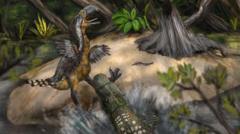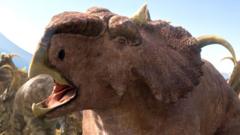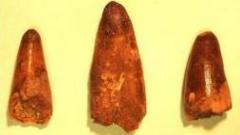A new species of dinosaur, Khankhuuluu mongoliensis, discovered in Mongolia, redefines our understanding of tyrannosaur evolution, indicating that this smaller predator is a crucial ancestor to giants like T. rex. The findings suggest a profound evolutionary transition from tiny, fleet-footed hunters to the formidable tyrannosaurs.
Newly Unearthed Dinosaur Species Challenges Tyrannosaur Evolution Theory

Newly Unearthed Dinosaur Species Challenges Tyrannosaur Evolution Theory
Khankhuuluu mongoliensis adds a significant chapter to the evolutionary tale of tyrannosaurs, shifting paradigms within the field of paleontology.
Scientists have recently revealed a groundbreaking discovery in the realm of paleontology: a new species of dinosaur that potentially alters the established understanding of the tyrannosaur family tree. This remarkable species, named Khankhuuluu mongoliensis, derived from Mongolian fossils, has been identified as the closest known ancestor to all tyrannosaurs, a lineage famously encompassing the iconic Tyrannosaurus rex.
Described in the journal Nature, Khankhuuluu, which translates to "Dragon Prince of Mongolia," sheds light on the evolutionary journey where these formidable predators emerged. This species is unique as it marks a significant step in understanding how tyrannosaurs evolved from small, nimble predators into the powerful giants that dominated North America and Asia before their extinction.
Prof. Darla Zelenitsky from the University of Calgary, a key researcher on this project, clarified that the title "Prince" reflects Khankhuuluu's status as an earlier, smaller member of the tyrannosauroid family—a superfamily of carnivorous dinosaurs. Fellow researcher Jared Voris emphasized that the early tyrannosauroids were relatively tiny and existed in the shadows of larger apex predators before evolving into giants like T. rex.
Approximately 750kg in weight, Khankhuuluu serves as a transitional fossil between its diminutive predecessors and the later monstrous forms of tyrannosaurs. The discovery has provoked a reevaluation of the dinosaur family tree, revealing the beginnings of key evolutionary traits, including the development of skull anatomy that would eventually allow for highly powerful biting capabilities—an essential trait for larger tyrannosaurs.
The fossils, first unearthed in Mongolia during the early 1970s, were previously misclassified as belonging to a different species, Alectrosaurus. Upon further examination, Voris recognized distinguishing features that warranted the designation of a new species.
The evolutionary journey of these dinosaurs also illustrates their ability to navigate between North America and Asia using ancient land bridges, promoting varied adaptations through the extensive timeframe of millions of years. As Zelenitsky noted, this finding reaffirms that the lineage that led to tyrannosaurs began with smaller, less imposing creatures before evolving into their iconic status. As the research continues, the implications of this discovery could reshape our comprehension of dinosaur evolution as a whole.










